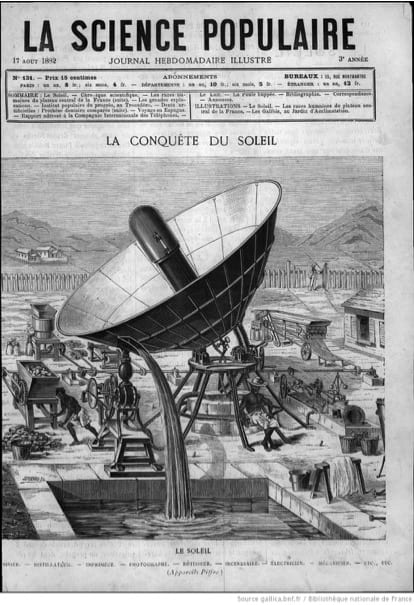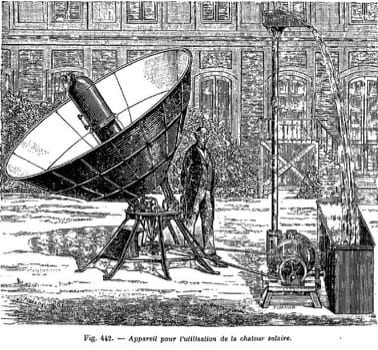by contributing editor Carolyn Taratko
In late summer of 1878, a visitor strolling the park at Trocadéro on a sunny day during the 1878 Exposition Universelle in Paris would have encountered an enormous silver-plated cone. Twenty-four square meters of reflective surface trapped the sun’s rays and converted their heat into usable energy, performing an astonishing array of tasks. Next to this strange contraption, a roast beef rested, having just emerged from the solar-powered oven. It cooled beside a rumbling steam engine that curiously lacked a combustion chamber. Behind this device, the world’s first solar-powered engine, was a provincial mathematics teacher from Tours, Augustin-Bernard Mouchot (1825-1912). His work, now forgotten, piqued the interest not only of the scientific establishment in Paris but also of the popular press long before its debut at the Exposition Universelle. After a trial run in Algeria, the device captured the French public’s imagination, the interest of the notoriously exclusive Académiciens at the Academy of Science and the patronage of France’s two successive political regimes between the construction of the first prototype in Tours in 1860 and the scaled-up model displayed at the 1878 Exposition.

The receptor sits amid several contraptions, similar to those that were displayed on the Champs de Mars at the Exposition Universelle. At the bottom of the page, a banner reading “The sun—cooking aid—distiller—printer—photographer—rotisserie—fire starter—electrician—mechanic—etc.—etc.” appears, heralding its versatility. Strikingly, two men, noticeably dark and lacking shirts, occupy the middle ground. One appears to be in the midst of tending to a machine (perhaps peeling potatoes before boiling them in a trough?) while the other sits, half-reclined upon the frame of the receptor, at rest. In the background, a small figure in a suit stands at the gate, surveying what lies in front of him. The self-assured title, “La Conquête du Soleil” suggests the conquest at work in the image: of the sun in its role as prime mover of nature, harnessing the rays to suit the needs of colonists. La Science Populaire. Paris, no.131 (17 Aug 1882).
Mouchot’s story is an interesting one, and not just on account of the delightful tremor of self-recognition upon discovering that something so apparently cutting-edge belonged to an earlier century. Mouchot’s device and its trajectory also allow us to pose questions about how he and his contemporaries thought about natural resources and energy. Seen in this way, it belongs to the “new” intellectual history which explores the ideas of individuals who are not normally considered intellectuals and are far outside the pantheon of celebrated scientists. Since the legacy of the man (as so often is the case) was eclipsed by his invention, the ideas he engaged with provide a more fruitful path for further inquiry than any sort of biographical preoccupation.
Not much is known of Mouchot’s life before his construction of the receptor. His earliest published work, La chaleur solaire et ses applications industrielles, appeared in 1869. In it, he describes the properties at work in the solar receptor and in early-stage experimentation. He credited recent developments that explored the role of heat in machines for opening the possibility of his invention. Mouchot’s first experiments with the solar receptor date from 1860 in Alençon, where he began his career as a mathematics teacher at the local lycée. Using modest materials—his first prototype involved a receptor fashioned from the blacked interior of a wooden crate—Mouchot began to apply the principles of solar heat and mechanical work.
In La chaleur solaire, Mouchot, a specialist in neither geology nor political economy, confidently asserted that Europe’s coal stocks would become exhausted. “Unlike our forests,” he wrote, “the coal stocks are not replenished, and yet we have seen the wood supply become more rare. Is there any reason to imagine that the situation with coal, one in which the deposits are never refilled, can avoid dearth?” And yet, Mouchot continued, “the consumption of coal worldwide increases annually, while scientists scramble to calculate the expiration date of this period of bounty.” With this in mind, Mouchot aimed to disabuse his readers of their false sense of security in the current coal-based energy regime.
This is a story about coal as much as it is one about solar power. La chaleur solaire provides a genealogy of the principles that informed Mouchot’s research, but it is also a tool of self-promotion. Mouchot self-consciously reproduces the language of a coal shortage, drawing attention to the promise of the solar energy as a “free resource” (ressource gratuite) in a way that was meant to draw the attention of official networks of patronage. Put differently, the problem he seeks to address is not just solely the creation of usable energy from the sun, but the creation of usable energy that does not rely upon coal.
While we are accustomed to hearing about “peak oil”, we often forget that “peak coal” was a legitimate concern in the nineteenth century. Western European nations, whose enormous industrial growth was predicated on a reliable supply of the stuff, fretted over its eventual exhaustion. Mouchot’s own vague allusions to the calculations of the rate of coal exhaustion drew upon the work of Louis Simonin in France and, more famously, William Stanley Jevons in Great Britain, both popularizers of the idea of coal shortage. Exhaustion, explained Jevons in his 1865 publication The Coal Question, signified a time when the costs of extracting coal rose to a point that it was no longer feasible. Jevons wrote within a British context, but these same anxieties made their way across the channel to France (a nation already poorly endowed with accessible coal). Innovations in mining technology had overcome these setbacks for the time being, but the growing demands of industry ensured that France would be playing consumption brinkmanship if alternatives were not sought out.

“Appareil pour l’utilisation de la chaleur solaire,”Dictionnaire encyclopédique et biographique de l’industrie et des arts industriels, (Paris: Lami, Tharel et Compagnie, 1891)
In the two decades spanning 1860 to 1880, the conversation about resource management was a conversation about coal extraction and trade– petroleum was slowly making inroads, but coal reigned. “Coal,” wrote Roderick Murchison, director of the British Geological Survey, was “the meter of power of modern nations” (Murchison to Layard, 23 Feb. 1866, Layard Papers, BLAM 39118, ff.410-411). The geological survey inaugurated an age in which mineral wealth provided an index of national power. The late nineteenth century displayed a tendency to measure its power not solely in terms of its standing army, but also its feedstock resources.
Mouchot set out to create a means for collecting and utilizing solar rays for the profit of agriculture and industry in warm regions. His technology was not merely one with applications confined to the borders of France; in fact its conditions for optimal results lie beyond the Hexagon. After nearly a decade of promoting his technology before provincial and national audiences, he secured support for an expedition Algeria in 1877. The results were promising. His application-first approach tested the utility of the receptor for tasks suited to the everyday needs of a military expedition. He traveled the country and systematically tested the caloric yield of his devices at various locations and altitudes. These included the distillation of water and alcohol, the baking of bread and cooking of meat, which were all tasks of great importance to the French military in light of the shortage of naturally occurring coal and tinder in Algeria. These minor uses were subordinate to the primary goal, which was to determine the utility of a large solar powered engine for agriculture, to power a motor for elevating water for irrigation purposes, and industry.
The journey to Algeria and the display at the 1878 Exposition Universelle furnish the climax of this story; afterwards both the man and his machine fade into obscurity. The difficulties of finding dependable sunlight in France proved to be a damning drawback, cited again and again in scientific proceedings and reports. Its utility in other climes was plain, but investment in technology solely suited to France’s colonial possession (which was itself an engagement of questionable at best economic return) was hard to justify. Eventually, the idea of a solar-powered engine was altogether abandoned and treated as a curiosity on display in a courtyard on the rue d’Assas in Paris.
This post begins with a story and finishes with a set of questions about what a history of ideas about the environment might offer. In addition to sufficient institutional resources, an energy shift requires a degree of imagination; it requires us to imagine alternatives that are not readily apparent. In its brief lifespan, Mouchot’s device captured the imagination of his contemporaries. (Mouchot appears as footnote in August Bebel’s sketch of socialist future outlined in Die Frau und der Sozialismus, which is how I myself came upon the topic.) Mouchot’s device partakes in the wider phenomenon of the forgotten history of alternative energy sources. These projects have been largely neglected by historians. They are either been taken as unremarkable, and thus unworthy of study (such is the case of wind and watermills); or due to their failure to take hold (as in this early case of solar power), they appeared casualties of “inevitable” progress fed by fossil fuels. Returning to these stories and attempting to reconstruct the moments of possibility can help us to see beyond the blinders of fossil fuel dependency that govern the modern world and to recapture earlier ideas about natural resources.



2 Pingbacks